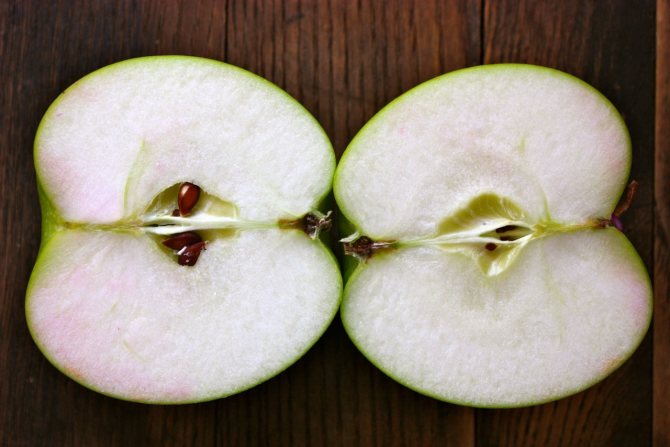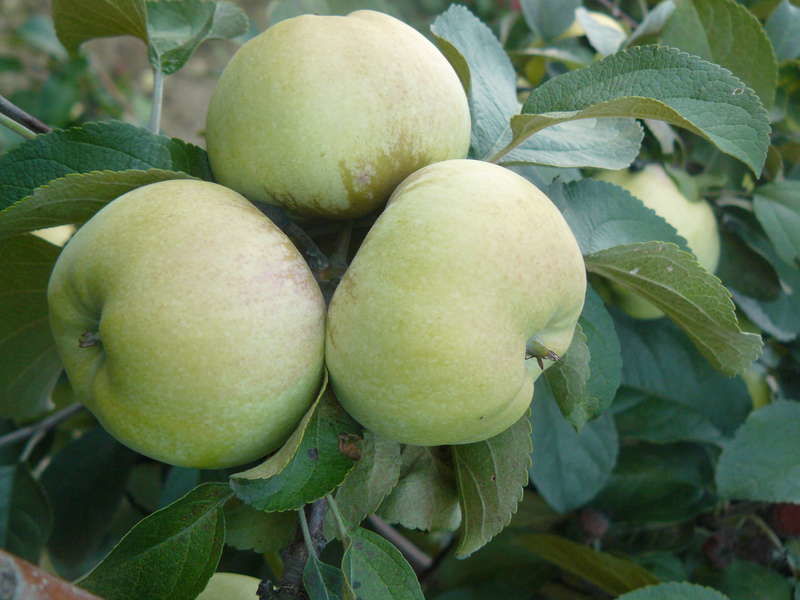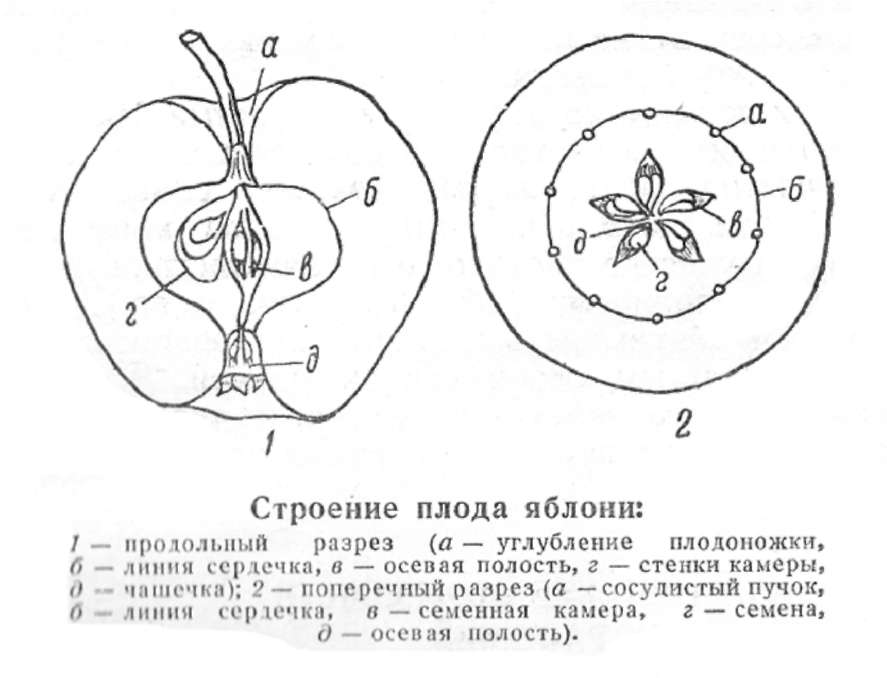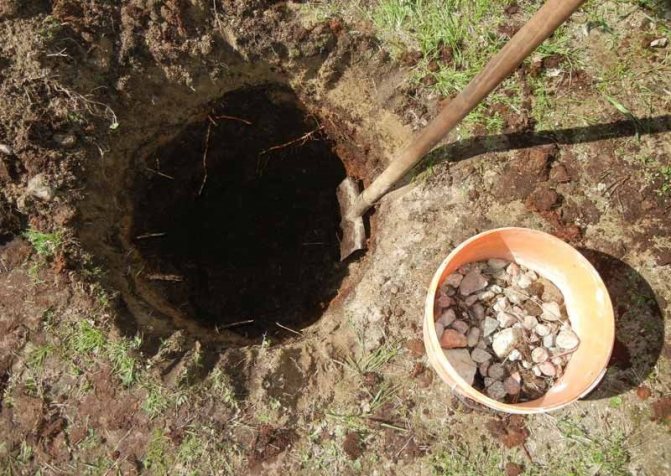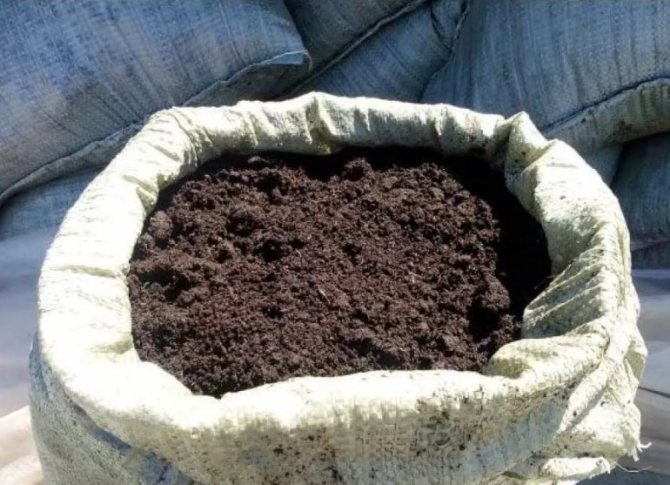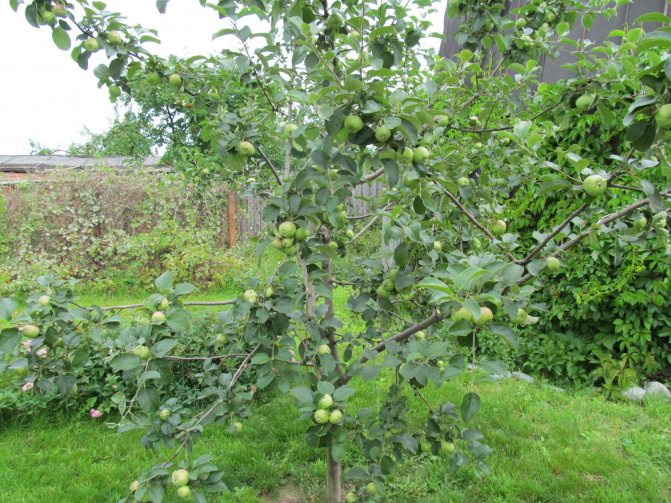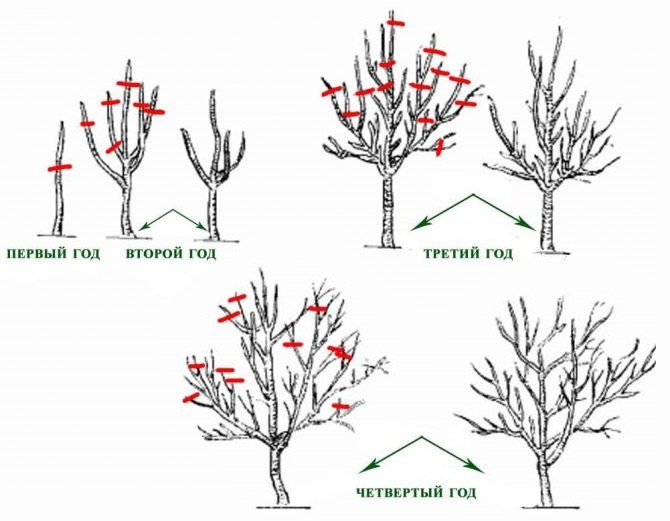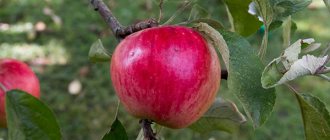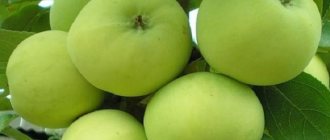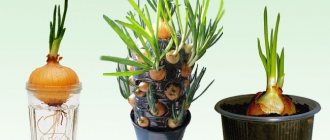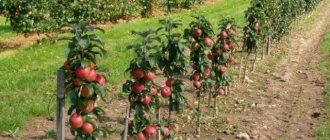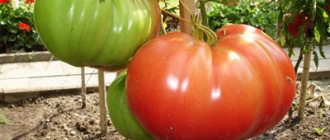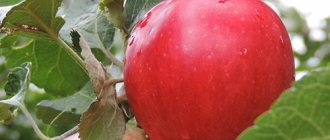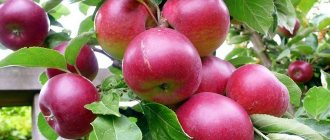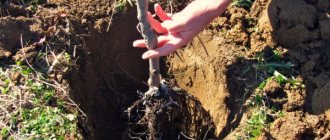»Gardening» Apple tree »Apple tree Bogatyr - the advantages of the variety
0
155
Article rating
The Bogatyr variety, created by the breeder S.F. Chernenko, has earned popularity for its good yield and pleasant sweet and sour taste. To create it, they used the well-known Antonovka and the Renet Landsberg variety widespread in Western Europe. From Antonovka, the apple tree received resistance to cold and high adaptability, from Renet - large size and tasty pulp.

Apple tree Bogatyr - the advantages of the variety
Variety characteristics
The hero belongs to the type of domestic apple tree. Late winter variety, suitable both for fresh consumption and for thermal processing.
Description of the tree and fruit
The variety got its name for a reason: the tree is tall and spreading, reaching a height of 6 m.
The shape of the crown is round or conical. Inside, she is naked, because new shoots do not grow there. The branches are strong, thick, the connection with the trunk is wide. The bark is greenish brown.
The leaf plate is oval, the lower surface is slightly pubescent, the edges are serrated. Spring bloom. The flowers are ordinary, pink-white.
Apples are formed mainly on ringlets - short rosette shoots, also on fruit twigs. The fruit is large, weighs an average of 160 g, but apples grow in 300-350 g.
The shape is flattened, with wide "ribs". The peel is thick, its surface is smooth, light green, after reaching maturity it turns yellow. The apple barrel, illuminated by the sun, is red.
Taste
The fruit tastes sweet with sourness. The pulp is hard, fine-grained, white, smells good, crunches when biting off. It contains less acids than Antonovka, so the taste is considered to be higher.
The nutritional value
The fruits of the Bogatyr variety have a low calorie content: in 100 g, only 43 kcal. Therefore, the fruit is recommended to be included in the diet for people who are losing weight.
The ratio of BZHU per 100 g:
- proteins - 0.4 g;
- fats - 0.4 g;
- carbohydrates - 9.8 g.
Late winter apples are rich in bioactive substances.
The composition includes:
- ascorbic acid (C) - a strong antioxidant that stimulates metabolism, prevents the development of atherosclerosis, supports the cardiovascular system (13 mg per 100 g of product);
- retinol (A) - helps in the fight against infection, regulates the functioning of the organs of vision;
- group of B vitamins - normalizes the processes of the brain and nervous system.
The mineral composition of apple pulp is rich in:
- potassium - has a positive effect on protein synthesis, participates in the conversion of sugars into energy, contributes to the saturation of the brain with oxygen, supports the functioning of the kidneys;
- manganese - regulates metabolic reactions, improves the endocrine and nervous systems, maintains a healthy level of hemoglobin, helps the full development of bone and connective tissues;
- also iron, zinc, phosphorus, calcium, magnesium.
Apple is a rich source of pectins, which are essential for the digestive tract.
The peel contains a lot of ussulic acid, which is necessary for the proper development of muscle tissues, preventing the spread of malignant cells.
Fruits are rich in fiber, which improves bowel function and removes harmful accumulations from the body.The catechins contained in the pulp normalize the level of cholesterol in the blood, strengthen the walls of blood vessels, inhibit infection and malignant cells, and inhibit the aging process.
Self-fertility
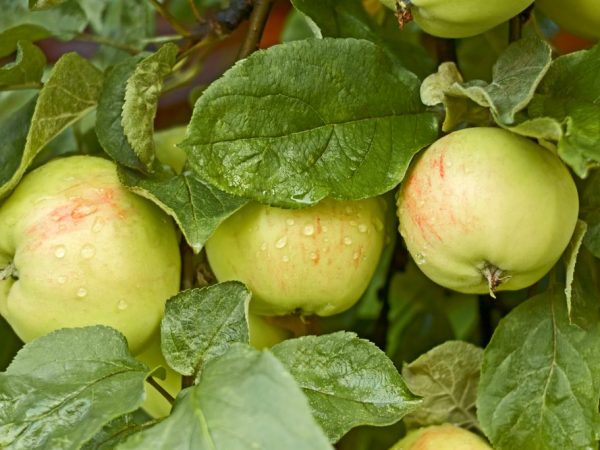

Pollinators will increase yields
Pollinators of other varieties should grow next to the Bogatyr apple tree. The best neighbors are Sinap Severny, Zhigulevsky, Streyfling, Melba.
Yield
The first fruits should be expected in the 4th year after planting a 2-year-old seedling. If eye grafting was carried out, then fruiting begins only in the 6th year.
Productivity is determined by the age of the tree: the older it is, the more abundant the apple harvest. From a 10-year-old apple tree, up to 60 kg are harvested, from a 15-year-old tree to 80 kg.
The abundance of the crop in some years may decrease.
Winter hardiness
The Bogatyr variety is winter-hardy. As it grows, the tree adapts to the surrounding conditions, does not react to the return cold. But annual and biennial seedlings should be mulched for the winter to protect the roots from severe frosts.
Disease and pest resistance
The apple tree is immune to scab, but it can get sick with powdery mildew. Among insect pests, aphids, hawthorn, apple moth, miner moth, fruit sapwood can attack.
Potential pests and diseases - prevention and control
The cultivar is scab resistant, but there are also other diseases and pests that need to be dealt with. These are apple moth, caterpillars, fungal diseases. As a preventive measure, pruning of old branches, spraying of trees, and whitening of trunks are carried out.
To destroy wintering caterpillars, you need to clean the bark, dig up the soil. At night, in the crowns of trees, you can hang jars with wandering baits (1/3 liter jar full). To prepare the bait, take 700 g of apples, pour 2 liters of water and boil for half an hour, then add 0.5 liters of milk whey, 0.5 liters of bread kvass, 20 g of yeast, 250 g of sugar and leave in a warm place. The bait will be ready when the liquid begins to ferment.
To protect apple trees from infection with fungal spores, in the spring, before the leaves appear, the soil and trees should be sprayed with copper sulfate or nitrafen (diluted with 300 g of water in 10 liters). At the end of April, trees are treated with Bordeaux liquid (3-4%). In the phase of bud formation and after they have faded, use Bordeaux liquid of a lower concentration (1%). To prevent fungus infection of apple trees next year, you need to remove fallen leaves and plow the soil under the trees.


To prevent the appearance of fungus on the apple tree, you need to remove fallen leaves and plow the soil on time every year.
Advantages and disadvantages
| pros | Minuses |
|
|
Landing
The apple tree prefers loam and sandy loam, planting in clay soil is undesirable. The site chosen for planting should be sunny, with deep groundwater.
Better to plant on a hill, in a low place the tree feels bad.
Since the Bogatyr variety is characterized by a spreading crown, the distance between the seedlings should be at least 5 m (with the exception of the columnar variety).
The space between them can be occupied with garden crops: radishes, cabbage, beans.
You can not plant only sunflower and corn: they take food for themselves.
Timing
Planting is carried out both in spring and autumn before frost. For spring planting, the hole is prepared in autumn, for autumn planting - 2 months before work.
Technology
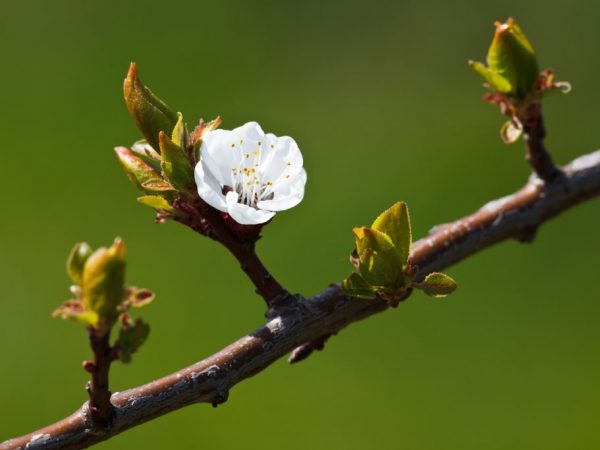

The tree needs to be well looked after
The volume of the planting hole should be 100 × 100 cm, the depth is not less than 70 cm. At the bottom, drainage is made 20 cm thick, pebbles, crushed stone, brick chips are used.
To improve the quality and nutritional value, sand, peat, humus are added to the soil.
Prepared seedlings are carefully examined, dried and rotten roots are cut off. To prevent decay of the root cuts, use a talker: mix clay and mullein in a 3: 1 ratio, dilute in water, dip the roots into this mass.
Description of the planting process:
- a mound of fertile soil is made in the hole;
- a seedling is placed on a mound, the roots are straightened;
- pour out a bucket of water;
- the hole is covered with fertile soil;
- the upper soil layer is enriched with potassium-phosphorus fertilizer (150 g per tree);
- a recess is made around the seedling for ease of watering, a second bucket of water is poured;
- the ground is mulched with straw or peat.
Choice of place and timing of boarding
If the apple tree is grown on a seed stock, it needs room for growth. Taking into account the spreading crown, the distance between neighboring trees should not be less than 6 m. The roots of the apple tree penetrate deeply into the soil and therefore are sensitive to high humidity in the lower layers of the soil, which means that the groundwater should not be high. Water should not accumulate at the landing site even in the spring when the snow melts. The Bogatyr apple tree is very plastic and can adapt to any growing conditions, but it will be best when planted in fertile loams in a sunny place.
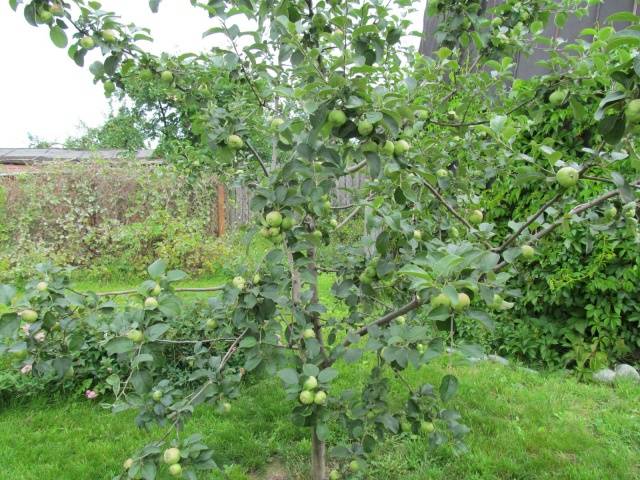

The timing of planting an apple tree largely depends on the growing region. In the south, autumn is long and the time between the end of the growing season and the onset of frost will be quite enough for the seedling to take root. In the middle lane and in the North-West, spring planting is preferable.
Care
To maintain the health and fertility of the Bogatyr apple tree, it is necessary to follow the rules of care, especially in the spring and autumn months.
- Young trees are watered once a week.
- After 2 months, watering is gradually reduced.
- Adult specimens are watered during the growing season 4-5 times, if the season is dry, then 8 times.
In the spring
At the end of March, pruning is carried out to stimulate the growth of fruiting shoots.
According to experienced gardeners, it is advisable to cut off the branches where flower buds were previously formed.
Spraying is carried out in mid-April to kill insect pests. The procedure is repeated when buds appear.
- For the first treatment, a solution of urea (7%) or ammonium nitrate (10%) is taken.
- For the second, Bordeaux solution (2%) or any broad-spectrum fungicide is used.
No feeding is needed for 2 years, there will be enough nutrients introduced during planting.
- Young trees that are not yet bearing fruit are fed in May with compost, urea or other sources of nitrogen.
- Adult fruiting apple trees are given nitrogen fertilizer during the budding period.
After watering, a liquid solution is introduced, including 100 l of water, 250 g of urea, 400 g of potassium sulfate, 500 g of superphosphate. 30 liters are poured under each tree.
In summer
Adult fruiting apple trees at the beginning of summer, when the fruits are tied, need nitrogen and potash feeding.
The following fertilizer is used: 30 l of water, 120 g of ammonium nitrate, 90 g of potassium sulfate and superphosphate. Watering is carried out before and after the procedure.
At the end of summer, when trees spend a lot of energy on the development and filling of fruits, nitrogen is excluded, only potassium-phosphorus complexes are used.
In a bucket (10 l) dissolve 50 g of nitrophoska, 5 g of potassium humate. An old apple tree requires 30 liters.
In autumn
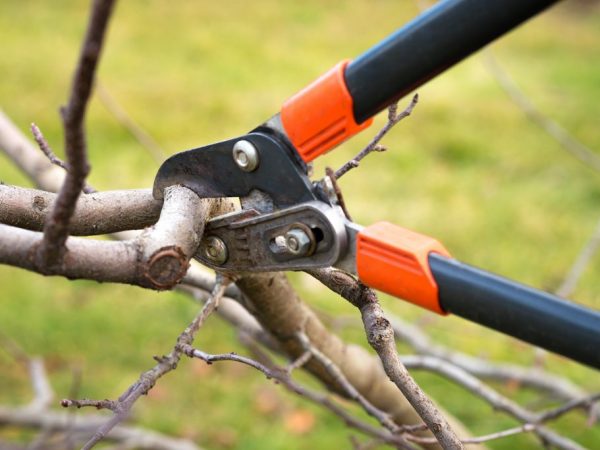

In the fall, diseased shoots are cut
Sanitary pruning is carried out: broken off, sick, shriveled shoots are cut off.
In early autumn, to prevent diseases and insect attacks, it is advisable to whitewash the trunks.
At the end, the soil is fertilized, ash, organic matter, superphosphate are added.Potassium sulfate can be used instead of ash.
Before the arrival of frost, the area around the tree is mulched with compost: in winter it will protect against frost, and in spring it will become an additional source of food.
Colds are not terrible for the variety, but it is better to cover young seedlings with spruce paws and fallen snow.
Plant features
The tree is tall and grows quickly. The skeleton is strong, the crown is spreading and rather sparse, therefore it is well lit, round or conical in shape. The lower skeletal branches are powerful, red-brown in color, branch off from the trunk almost perpendicularly, and those located above - at an angle of 45 °. Fruiting occurs on the ringlets formed on the branches of 3-4 years of age. Sometimes the crop is formed on last year's growth.


The tree blooms in May, flowers with white-pink petals, rather small in size, almost flat
Kidney awakening is good, the ability to shoot is below average. Shoots are long, curved, with appressed large oval buds. Leaves are dark green, semicircular with crenate serration along the edge. To the touch, the leaves are thick, leathery ("shagreen"), with a slight bend along the central vein and folded upward edges.
The cultivar is self-infertile, so it needs a pollinator, for example, Spartan, Streifling or Northern Sinap.
Early maturity is assessed as low. Gardeners in their reviews of the Bogatyr apple note that trees on ordinary seed stocks (tall - about 4-5 meters, with a spreading crown - 5-6 meters in diameter) begin to bear fruit from 4-5 years after planting in a permanent place. According to experts, fruit plants bear fruit in the 6-7th year after budding. Average long-term yield at the age of 9-14 years - 57 kg per tree, at the age of 12-17 years - 80 kg.


Apple tree "Streyfling" ("Shtrifel" or "Autumn striped") is an excellent pollinator for "Hero"
Harvesting and storage
Apples can be eaten in winter, they can lie until May, sometimes even until June. Moreover, neither nutritional characteristics, nor commercial attractiveness are lost.
The fruits can be soaked, used for compote or jam. Store them in dry and cool conditions.
You need to soak according to the following classic recipe:
- Prepare the marinade at the rate of 5 liters per 10 kg. For 1 liter of hot boiled water, 2 tablespoons of salt and sugar. Add 4 liters of cold water to the cooled solution.
- At the bottom of the cooked dishes, washed currant, raspberry, mint branches are placed.
- Apples are laid on top without pressing.
- From above, the fruits are tightly covered with mint leaves, the remaining branches of currants and raspberries.
- The workpiece is poured with marinade so that it completely covers the fruits.
- A thin board is placed on the dishes, pressed with a load. The marinade is gradually added over the course of the week. On day 9, dishes with soaked apples are taken out to a cool room, left for 50 days.
Suitable region and climate


At first, the variety was grown only in Ukraine and in the southern regions of Russia, but after a while, it began to enjoy incredible popularity in the Central and Central Black Earth regions, as well as in the North-Western regions of Russia.
Today, Bogatyr is found in the Urals, Siberia and the Far East, but in these regions the cultivation of the species is fraught with certain difficulties: the variety has low frost resistance, therefore, fruit trees must be covered for the winter.
Subspecies and variants
There are several varieties of the Bogatyr apple tree. Their external characteristics do not affect the quality of the fruit.
Derived:
- Dwarf subspecies. Height up to 4 m. The root system is superficial. Fruits appear at 4 years of age.
- On a semi-dwarf rootstock. Height from 4 m. Root system up to 1.5 m deep. Fruits appear in 4 - 5 years.
- On a columnar rootstock. The tree looks compact, so the subspecies is recommended for gardeners who do not have enough space on the site.When planting, the formation of the root system is required. Grooming necessarily includes regular pruning.
Preparing the seedling and planting pit
Prepare the pit at least two weeks in advance for autumn planting and from fall for spring planting. The soil in the hole should be compacted so that there are no air bubbles left in the soil in which the roots of the seedling cannot develop. For the same purpose, you will need to lightly shake the apple tree seedling when planting, covering its roots with earth. It is very important that by the time of spring planting, fertilizers can already be well absorbed by the plants. Some of them, especially phosphoric ones, dissolve slowly. Therefore, it is better to prepare the nutrient soil for filling the hole in advance.
The depth and diameter of the pit on the loam is 0.8 m. Sandy loam soils are poorer, so the hole should be dug more. If the soil is completely clayey, you cannot plant an apple tree on a seed stock. It is possible to plant the graft on a dwarf rootstock, but in a loose mound.
If you bought an apple tree seedling with open roots, its root system must be placed in a container with water a day before planting. After that, the roots are examined, the damaged ones are cut off. To disinfect the sections, they must be covered with crushed coal. It is very good to dip the roots of the apple tree in a mash made of clay, to which a root formation stimulator has been added.
Growing regions
The Bogatyr variety is zoned for the Moscow region and the Central strip. The climate and soils are ideal for the apple tree. Subject to agrotechnical rules, the yield is high.
Cultivation is also possible in the Urals, although the soil cover is not entirely suitable. For full development, it is necessary to apply fertilizers in a timely manner, take care of the site, loosen, water, mulch before winter.
In the western and eastern regions of Siberia, the winter-hardy variety Bogatyr takes root without problems. Agrotechnical rules are standard.
Breeding history and zoning of the variety
A variety of domestic selection, bred at the end of the 20s of the last century by the famous breeder S.F. IV Michurina by crossing the popular variety "Antonovka ordinary" with "Renet Landsberg".


"Antonovka ordinary" (pictured) is a valuable initial form in breeding winter-hardy varieties. On its basis, 25 new species have been created, including "Bogatyr", "Vishnevaya", "Orlovim" and others.
Since the end of the 40s "Bogatyr" has been under state variety testing and in 1971 it was officially entered into the State Register of Breeding Achievements of the Russian Federation. The variety is zoned and recommended for industrial and amateur gardening in the North-West, Central, Volgo-Vyatka and Central Black Earth regions of our country. Due to a number of advantages and high ecological adaptability, this variety of apple trees is successfully grown in Ukraine, Belarus and other neighboring countries.
Gardeners reviews
The reviews are mostly positive. Notice:
- resistance to temperature extremes and winter frosts;
- strong appearance and active development of the tree;
- good yield;
- immunity to scab;
- long shelf life;
- high nutritional value and good tasting qualities of apples.
The Bogatyr apple tree is not capricious, resistant to adverse conditions. It is enough to carry out preventive measures against infection and insects in a timely manner so that the tree remains healthy and annually pleases with a bountiful harvest.
Reproduction
The hybrid apple variety Bogatyr was bred by Semyon Fedorovich Chernenko by crossing the varieties Antonovka and Renet Landsberg. Therefore, it is undesirable to propagate the culture with seeds. You can get a completely different variety or wild.
It is better to propagate by grafting in the spring. To do this, take a cutting from an annual plant. Cut a side branch at an angle. On the rootstock, select a large branch, make a deep cut and insert the stalk.Cover the incision with garden varnish, plasticine or wrap with electrical tape. The grafting was successful when the leaves appeared on the handle. We have detailed when it is best to vaccinate an apple tree.

